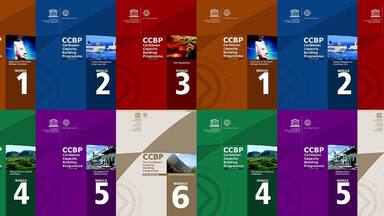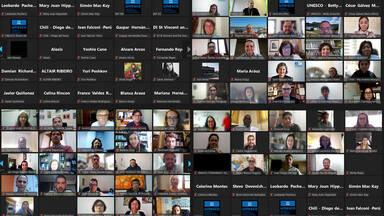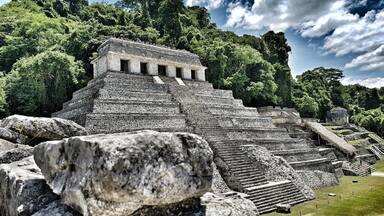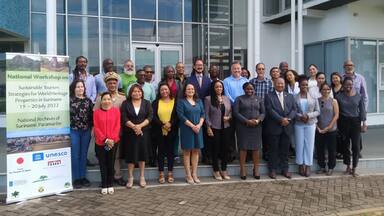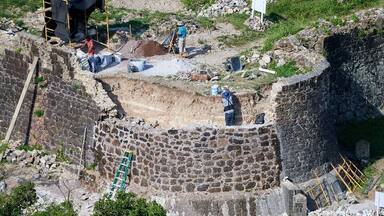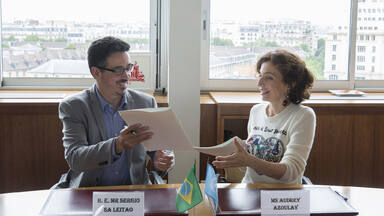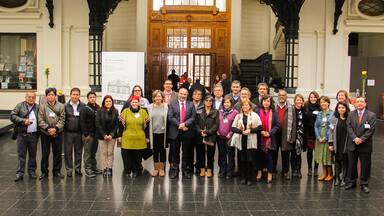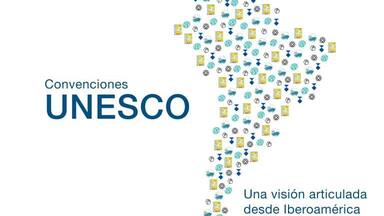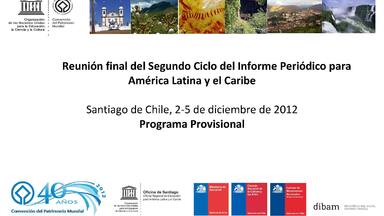From archaeological pre-Hispanic sites, exceptionally well preserved historical centres, breath-taking natural sites with exquisite, biodiverse landscapes, the Region’s World Heritage serves as a basis for further strengthening sustainable development and the role of local communities which is vital for heritage protection and management.
A well protected World Heritage site contributes directly to environmental, social and economic development and helps better the life of the local community. This process constitutes a great challenge for the years to come, both for the State Parties to the Convention and for UNESCO.
Cultural Properties
Mixed Properties
Natural Properties
Transboundary properties
Properties in Danger
Periodic Reporting
The Periodic Reporting process in the Latin America and the Caribbean Region
Third Cycle (2021) and Action Plan for Latin America and the Caribbean (2023–2029)
The 3rd cycle of Periodic Reporting for Latin America and the Caribbean was launched in October 2021. It involves all properties inscribed on the World Heritage List from the region, including those inscribed by the Committee at its Extended 44th session of the World Heritage Committee in July 2021.
The Third cycle of Periodic Reporting for Latin America and the Caribbean was launched in October 2021. It involves all properties inscribed on the World Heritage List from the region, including those inscribed by the Committee at its Extended 44th session of the World Heritage Committee in July 2021.
The objective of the Periodic Reporting is to highlight the work made by all the actors involved in the management and conservation of the sites and have a clear picture on how the World Heritage Convention is being implemented at national and local levels.
Guidance and Training Tools (English and Spanish) have been prepared to facilitate the filling up of the two Sections of the Questionnaire for the Third Cycle by National Focal Points and World Heritage Site Managers.
The Third Cycle of the Periodic Reporting for Latin America and the Caribbean resulted into the inclusive, participatory elaboration and draft of the Action Plan for Latin America and the Caribbean (2023–2029), which was formally adopted by the World Heritage Committee at its 45th-extended session. The Action Plan includes five strategic objectives:
- Strengthen the representativity and credibility of the Latin America and the Caribbean diverse heritage in the World Heritage List;
- Reinforce effective management for the conservation and promotion of World Heritage in the region;
- Develop and implement capacity-building for innovative approaches to conservation, management and promotion of World Heritage;
- Enhance better use of heritage education, communication and awareness-raising formulas for the protection of World Heritage;
- Reinforce community participation and stakeholder engagement for effective management of World Heritage properties.
A set of expected results, activities and performance indicators are connected, in the Action Plan, to each of the Strategic Objectives.
Download Action Plan Download Action Plan in SpanishDownload Report
Second Cycle (2013)
The objective of the Second Cycle was to the strengthen State Parties' capacities in order to contribute to the completion of the Retrospective Inventory exercise and the Retrospective Statements of Outstanding Universal Value for World Heritage properties in the LAC Region. Its official launch took place during the 35th Session of the Committee in 2011.
First Cycle (2004)
The First cycle was implemented in accordance with the World Heritage reporting mechanisms (1998) and the strategic objectives of the Convention (2002). This report constitutes the first periodic report on the state of World Heritage in the LAC Region and was examined by the World Heritage Committee at its 28th session (Suzhou, 2004).
As follow up of Decision 37 COM 10A adopted by the World Heritage Committee at its 37th session (Phnom Penh–2013) and based on the results of the 2nd cycle of the Periodic Reporting exercise, the LAC State Parties, in close cooperation with the World Heritage Centre, the Advisory Bodies and Category 2 Centres developed regional and sub-regional Action Plans. When the Third Cycle is concluded, a new Action Plan for the Region will be developed taking into consideration the results obtained.
Action Plans
At its 38th session (Doha, 2014), the Committee congratulated the LAC State Parties for their efforts and adopted the Action Plan for World Heritage in Latin America and the Caribbean 2014-2024. The Committee further encouraged State Parties to continue working with the World Heritage Centre, the Advisory Bodies and the Category II Centres to develop sub-regional action plans (Decision 38 COM 10B.4)
Regional Action Plan
As follow up of Decision 37 COM 10A adopted by the World Heritage Committee and based on the results of the 2nd cycle of the Periodic Reporting exercise, the LAC States Parties, in close cooperation with the World Heritage Centre, the Advisory Bodies and Category 2 Centres, developed the Regional Action Plan (PARALC, 2014-2024) to address the key challenges and priorities regarding World Heritage across the region.
Sub-regional Action Plans
By Decision 38COM 10B.4, the Committee encouraged the States Parties to continue working, in close cooperation with the World Heritage Centre, the Advisory Bodies and the Region’s Category 2 Centres, to develop sub-regional action plans, based on the Action Plan for World Heritage (PARALC 2014-2024) and building upon the achievements of the previous plan with a focus on the specific needs of each sub-region.
Capacity Building
Strategic Objective for the implementation of the Convention
The Second cycle of the Periodic Reporting exercise identified the lack of management capacity and expertise as one of the pressing needs in some countries from the region preventing them from ensuring better protection for the World Heritage sites within their territory. In this context, the Regional Action Plan (PARALC 2015-2024) outlines a Capacity Building Strategy (EFCAS) in order to support the Category 2 Centres in the Region in elaborating Capacity Building strategies and programmes tailored to the specific needs of the 3 LAC sub-regions (Mexico and Central America, the Caribbean, South America) aiming to address their most urgent requirements.to support the implementation of the World Heritage Convention.
Extra-budgetary Projects
The projects financed with extra-budgetary resources form an essential part of the Action Plan of World Heritage for the Region. They support several conservation and management activities, which cannot be supported only with regular budget funds, and which tackle key priorities for the Region.
Thanks to these donors and partners, WHC-LAC is able to enhance its action regarding conservation, management, technical assistance, seminars, workshops, training courses, database creation and others.
LAC UNESCO field partners
Field offices
Conservation, protection and capacity building activities in the region are carried out through reinforced cooperation among the State Parties, the World Heritage Centre, the Advisory Bodies and UNESCO Offices in the field. The network of field offices plays an essential role in the implementation of specific activities.
Category II Centres
Created in order to assist and support the State Parties of the three LAC sub-regions to implement the 1972 World Heritage Convention. Two centres have been created: the Category II Centre “Lucio Costa Regional Training Center in Cultural Heritage Management (CLC)” for the South American sub-region, and the Category II Centre “Regional World Heritage Institute in Zacatecas (RWHIZ)” for Mexico, Central America and the Caribbean.
Decisions (6)
The World Heritage Committee,
- Having examined document WHC/23/45.COM/10B,
- Recalling Decisions 41 COM 10A, 42 COM 10A, 43 COM 10B and 44 COM 10D adopted at its 41st (Krakow, 2017), 42nd (Manama, 2018), 43rd (Baku, 2019) and extended 44th (Fuzhou/Online, 2021) sessions respectively,
- Commends the efforts of States Parties in the Latin America and the Caribbean region in the completion and submission of Section I, and the very high level of completion and submission of Section II of the Periodic Reporting questionnaire;
- Thanks the Regional World Heritage Institute in Zacatecas (Mexico) and the Regional Heritage Management Training Centre ‘Lucio Costa’ (Brazil), and Advisory Bodies in facilitating the Periodic Reporting exercise in the region;
- Welcomes with satisfaction the Third Cycle Regional Report in Latin America and the Caribbean and encourages the States Parties to widely disseminate it among all relevant stakeholders in the region;
- Takes note of the planned publication of the Third Cycle Periodic Report in the Latin America and the Caribbean region in the World Heritage paper series, subject to the availability of funding resources, and invites States Parties to contribute financially for this purpose;
- Also commends the joint efforts made by the national Focal Points and World Heritage site managers, the UNESCO World Heritage Centre and the Advisory Bodies in producing an Action Plan framework in an adaptable format, in order to facilitate its appropriation and implementation by the States Parties;
- Endorses the Third Cycle Regional Framework Action Plan developed in cooperation with all States Parties and other heritage stakeholders in the region and notes with satisfaction that the priorities align with those set out in the Declaration unanimously adopted at the UNESCO World Conference on Cultural Policies and Sustainable Development – MONDIACULT 2022 (Mexico City, 2022) and the reflections undertaken at the international conference ‘The Next 50 - The Future of World Heritage in Challenging Times, Enhancing Resilience and Sustainability’ (Delphi, 2022);
- Encourages States Parties to appropriate the Third Cycle Regional Framework Action Plan into their national and sub-regional heritage strategies and policies, and requests the World Heritage Centre, in collaboration with the Advisory Bodies, the Category 2 Centres, and other partners, to support States Parties in its implementation;
- Also requests the UNESCO World Heritage Centre to monitor the implementation of the Framework Regional Action Plan in view of preparing a mid-cycle assessment report to be presented to World Heritage Committee after three years.
The World Heritage Committee,
- Having examined Document WHC/23/45.COM/10D,
- Recalling Decision 44 COM 10C.4 adopted at its extended 44th session (Fuzhou/online, 2021),
- Welcomes the progress made in the follow-up of the Second Cycle of Periodic Reporting for Latin America and the Caribbean,
- Thanks the Governments of Flanders (Belgium), Germany, Japan, the Netherlands, the Republic of Korea, Norway as well as the World Bank and European Union for their contributions towards supporting follow-up activities to the Second Cycle of Periodic Reporting in the region of Latin America and the Caribbean.
The World Heritage Committee,
- Having examined Document WHC/16/40.COM/10B,
- Recalling Decisions 37 COM 10A, 38 COM 10B.4 as well as 39 COM 10B.4, adopted at its 37th (Phnom Penh, 2013), 38th (Doha, 2014) and 39th (Bonn, 2015) sessions respectively,
- Takes note of the progress accomplished in the follow-up activities of the second cycle of the Periodic Reporting for Latin America and the Caribbean regarding the Retrospective Inventory process and encourages the States Parties of the region to continue their efforts in the implementation of its recommendations;
- Reminds States Parties which have not already done so to submit their Retrospective Statements of Outstanding Universal Value by 1 February 2017 at the latest, as well as clarifications of boundaries by 1 December 2016 at the latest;
- Notes with appreciation the contribution of the Centre Lucio Costa for Capacity-Building on Heritage Management (C2C-LCC), category 2 centre under the auspices of UNESCO, to the development and implementation of a Capacity-Building Strategy as a follow-up to the Action Plan for World Heritage in South America 2015-2020 (PAAS 2015-2020) and encourages the Centre to continue its cooperation with the World Heritage Centre on the implementation of the Capacity Building Programme and activities related to World Heritage;
- Reiterates its request to Central American States Parties to work in close coordination with the World Heritage Centre to organize a meeting for the establishment of a sub-regional Action Plan with the participation of all stakeholders;
- Takes note of the progress made with a view to consolidate the establishment of the UNESCO category 2 centres for World Heritage in Zacatecas (Mexico) and in Rio de Janeiro (Brazil) and encourages Mexico and Brazil to continue their efforts in this regard;
- Requests the World Heritage Centre to present a progress report on the implementation of the Action Plan for Latin America and the Caribbean that allows a comparison of implementation status with the approved Action Plan at its 41st session in 2017.
The World Heritage Committee,
- Having examined document WHC-15/39.COM/10B,
- Recalling Decision 38 COM 10B.4 adopted at the 38th session (Doha, 2014);
- Takes note of the progress accomplished in the follow-up activities of the second cycle of the Periodic Reporting for Latin America and the Caribbean and encourages the States Parties of the region to continue their efforts in the implementation of its recommendations;
- Notes with appreciation the elaboration of the two sub-regional Action Plans for the Caribbean and for South America;
- Further notes with appreciation the support of the Government of Peru for the organization of the sub-regional meeting for the elaboration of the World Heritage Action Plan for South America (Cuzco, 5 to 7 May 2015);
- Encourages Central American States Parties to work in close coordination with the World Heritage Centre to organize a meeting for the establishment of a sub-regional Action Plan with the participation of all stakeholders;
- Encourages Mexico and Brazil to continue their efforts in view to consolidate the establishment of the UNESCO category 2 centres for World Heritage in Zacatecas (Mexico) and in Rio de Janeiro (Brazil);
- Reminds States Parties which have not already done so to submit their Retrospective Statements of Outstanding Universal Value by 1 February 2016 at the latest, as well as clarifications of boundaries by 1 December 2015 at the latest;
- Takes note that, in conformity with Decision 38 COM 10B.4, the World Heritage Centre will provide a report on the progress made in the implementation of the regional and sub-regional Action Plans at its 40th session in 2016.
The World Heritage Committee,
- Having examined Document WHC-14/38.COM/8E,
- Congratulates the States Parties for the excellent work accomplished in the elaboration of retrospective Statements of Outstanding Universal Value for World Heritage properties in their territories;
- Adopts the retrospective Statements of Outstanding Universal Value, as presented in the Annex of Document WHC-14/38.COM/8E, for the following World Heritage properties:
- China: Wulingyuan Scenic and Historic Interest Area;
- Japan: Gusuku Sites and Related Properties of the Kingdom of Ryukyu; Historic Monuments of Ancient Nara; Historic Villages of Shirakawa-go and Gokayama; The Hiroshima Peace Memorial (Genbaku Dome);
- Sri Lanka: Sinharaja Forest;
- Vietnam: Hoi An Ancient Town; Complex of Hué Monuments;
EUROPE AND NORTH AMERICA:
- Albania: Butrint;
- Armenia: Monastery of Geghard and the Upper Azat Valley;
- Austria: Semmering Railway; Wachau Cultural Landscape;
- Azerbaijan: Walled City of Baku with the Shirvanshah's Palace and Maiden Tower;
- Belarus / Estonia / Finland / Latvia / Lithuania / Moldova / Norway / Russian Federation / Sweden / Ukraine: Struve Geodetic Arc;
- Belgium: Major Town Houses of the Architect Victor Horta (Brussels); Neolithic Flint Mines at Spiennes (Mons); Notre-Dame Cathedral in Tournai; Plantin-Moretus House-Workshops-Museum Complex;
- Bosnia and Herzegovina: Old Bridge Area of the Old City of Mostar;
- Cyprus: Paphos;
- Denmark: Ilulissat Icefjord;
- Finland: Bronze Age Burial Site of Sammallahdenmäki; Fortress of Suomenlinna; Old Rauma; Petäjävesi Old Church; Verla Groundwood and Board Mill;
- Georgia: Historical Monuments of Mtskheta; Upper Svaneti;
- Germany / Poland: Muskauer Park / Park Mużakowski;
- Germany: Abbey and Altenmünster of Lorsch; Bauhaus and its Sites in Weimar and Dessau; Castles of Augustusburg and Falkenlust at Brühl; Collegiate Church, Castle and Old Town of Quedlinburg; Garden Kingdom of Dessau-Wörlitz; Luther Memorials in Eisleben and Wittenberg; Monastic Island of Reichenau; Palaces and Parks of Potsdam and Berlin; Pilgrimage Church of Wies; St Mary's Cathedral and St Michael's Church at Hildesheim; Völklingen Ironworks; Wartburg Castle; Würzburg Residence with the Court Gardens and Residence Square; Zollverein Coal Mine Industrial Complex in Essen;
- Holy See / Italy: Historic Centre of Rome, the Properties of the Holy See in that City Enjoying Extraterritorial Rights and San Paolo Fuori le Mura;
- Holy See: Vatican City;
- Iceland: Þingvellir National Park;
- Italy: Botanical Garden (Orto Botanico), Padua; Ferrara, City of the Renaissance, and its Po Delta; Historic Centre of Florence; Historic Centre of Naples;
- Lithuania / Russian Federation: Curonian Spit;
- Lithuania: Kernavė Archaeological Site (Cultural Reserve of Kernavė);
- Malta: City of Valletta; Hal Saflieni Hypogeum; Megalithic Temples of Malta;
- Mongolia / Russian Federation: Uvs Nuur Basin;
- Montenegro: Natural and Culturo-Historical Region of Kotor;
- Netherlands: Historic Area of Willemstad, Inner City and Harbour, Curaçao;
- Norway: Vegaøyan -- The Vega Archipelago; West Norwegian Fjords – Geirangerfjord and Nærøyfjord;
- Poland: Centennial Hall in Wrocław; Historic Centre of Warsaw;
- Portugal: Historic Centre of Évora; Landscape of the Pico Island Vineyard Culture; Monastery of Alcobaça; Monastery of the Hieronymites and Tower of Belém in Lisbon;
- Russian Federation: Church of the Ascension, Kolomenskoye; Historical Centre of the City of Yaroslavl; Kizhi Pogost;
- Slovakia: Bardejov Town Conservation Reserve; Vlkolínec;
- Slovenia: Škocjan Caves;
- Spain: Archaeological Ensemble of Mérida; Burgos Cathedral; Historic Centre of Cordoba; Monastery and Site of the Escurial, Madrid; Monuments of Oviedo and the Kingdom of the Asturias; Mudejar Architecture of Aragon; Old City of Salamanca; Old Town of Ávila with its Extra-Muros Churches; Old Town of Cáceres; Old Town of Segovia and its Aqueduct; Poblet Monastery; Route of Santiago de Compostela; Royal Monastery of Santa María de Guadalupe; San Cristóbal de La Laguna; Santiago de Compostela (Old Town); Works of Antoni Gaudí;
- Turkey: Archaeological Site of Troy; City of Safranbolu; Hattusha: the Hittite Capital; Xanthos-Letoon;
- Ukraine: Kiev: Saint-Sophia Cathedral and Related Monastic Buildings, Kiev-Pechersk Lavra;
- United Kingdom: Gough and Inaccessible Islands; Henderson Island; Historic Town of St George and Related Fortifications, Bermuda;
- United States of America: Cahokia Mounds State Historic Site; Chaco Culture; Independence Hall; Mesa Verde National Park; Monticello and the University of Virginia in Charlottesville; Statue of Liberty;
LATIN AMERICA AND THE CARRIBBEANS:
- Argentina: Ischigualasto / Talampaya Natural Parks; Los Glaciares; Península Valdés;
- Belize: Belize Barrier Reef Reserve System;
- Bolivia: City of Potosí;
- Brazil: Brasilia; Historic Centre of Salvador de Bahia; Historic Centre of São Luís; Historic Centre of the Town of Diamantina; Historic Centre of the Town of Goiás; Historic Centre of the Town of Olinda; Historic Town of Ouro Preto; Sanctuary of Bom Jesus do Congonhas;
- Colombia: Los Katíos National Park;
- Costa Rica / Panama: Talamanca Range-La Amistad Reserves / La Amistad National Park;
- Cuba: Archaeological Landscape of the First Coffee Plantations in the South-East of Cuba; San Pedro de la Roca Castle, Santiago de Cuba; Urban Historic Centre of Cienfuegos; Viñales Valley;
- Dominican Republic: Colonial City of Santo Domingo;
- Guatemala: Tikal National Park;
- Panama: Coiba National Park and its Special Zone of Marine Protection; Fortifications on the Caribbean Side, Portobelo and San Lorenzo;
- Suriname: Central Suriname Nature Reserve; Historic Inner City of Paramaribo;
4. Decides that retrospective Statements of Outstanding Universal Value for World Heritage properties in Danger will be reviewed by the Advisory Bodies in priority;
5. Further decides that, considering the high number of retrospective Statements of Outstanding Universal Value to be examined, the order in which they will be reviewed by the Advisory Bodies will follow the Second Cycle of Periodic Reporting, namely:
- World Heritage properties in the Arab States;
- World Heritage properties in Africa;
- World Heritage properties in Asia and the Pacific;
- World Heritage properties in Latin America and the Caribbean;
- World Heritage properties in Europe and North America;
6. Takes note that the World Heritage Centre is in the process of harmonising all sub-headings in the adopted Statements of Outstanding Universal Value and, as appropriate, reflects name changes of World Heritage properties throughout the text of the Statements as requested by the Committee at its 37th session, and requests the World Heritage Centre to also update the size of the property and/or its buffer zone, as appropriate, following subsequent Decisions of the World Heritage Committee concerning Minor Boundary Modifications.
7. Requests the States Parties to provide support to the World Heritage Centre for translation of the adopted Statements of Outstanding Universal Value into English or French respectively, and finally requests the Centre to upload the two language versions on its website.
The World Heritage Committee,
- Having examined document WHC-14/38.COM/10B,
- Recalling Decision 37COM 10A adopted at the 37th session (Phnom Penh, 2013),
- Congratulates the States Parties of Latin America and the Caribbean region for their efforts to continue follow-up actions to the exercise of the second cycle of the Periodic Reporting exercise for Latin America and the Caribbean, and adopts the 2014-2024 regional Action Plan;
- Notes with appreciation the support of the Government of Brazil and the National Institute for Historic and Artistic Heritage (IPHAN) in organizing the regional meeting “Towards defining an Action Plan for World Heritage in Latin America and the Caribbean”, in close cooperation with the World Heritage Centre, UNESCO Office in Brasilia, the Advisory Bodies and the category 2 centres of the Region;
- EncouragesStates Parties and all other World Heritage partners and stakeholders in Latin America and the Caribbean to cooperate actively to ensure the implementation of the Action Plan, which reflects regional priorities to include, but not limited to, education and public awareness, disaster risk management, integrated heritage management, and sustainable tourism in World Heritage properties;
- Calls upon the States Parties from the Region to support the implementation of the 2014-2024 Action Plan and also encourages them to provide technical and financial resources at national level for its implementation;
- Further encourages States Parties to continue working, in close cooperation with the World Heritage Centre, Advisory Bodies and the Region’s category 2 centres, to develop sub-regional action plans, based on the Action Plan and taking into consideration and building upon the achievements of the previous plan with a focus on the specific needs of each sub-region;
- Acknowledges the progress made by the States Parties of Mexico and Brazil in effectively establishing the UNESCO category 2 centre for the World Heritage in Zacatecas, Mexico, as well as the UNESCO Lucio Costa category 2 centre of Rio de Janeiro, Brazil, and strongly encourages them to continue their efforts in cooperation with the World Heritage Centre, States Parties and Advisory Bodies to initiate a capacity-building programme for the management and conservation of World Heritage in the region;
- Also calls upon States Parties from other regions to support the efforts of the Latin American and the Caribbean Region in implementing the Action Plan, in the spirit of the international cooperation promoted by the World Heritage Convention;
- Reminds States Parties which have not already done so to submit their Retrospective Statements of Outstanding Universal Value by 1 February 2015 at the latest, as well as clarifications of boundaries by 1 December 2014 at the latest;
- Requests the World Heritage Centre to provide information on the progress made in the implementation of the regional Action Plan and sub-regional action plans at its 40th session in 2016.






